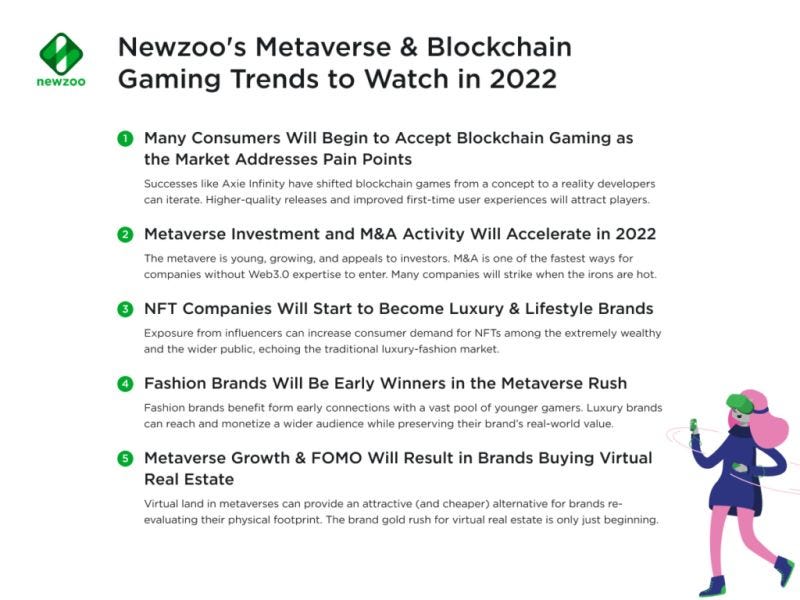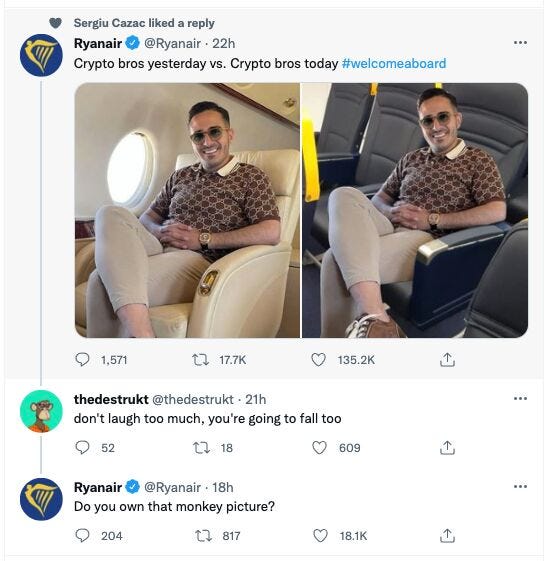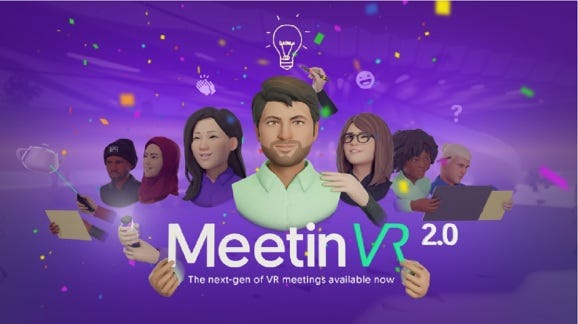Spatial Newsletter™ #026
This week we're going to look at VR collaboration, AR for marketing, Gen2Web3, Blockchain gaming, NFTs, DAOs & leadership, tokenomics, crypto & ethics, DeSci, and more!
Welcome to Spatial Newsletter™, the world’s largest online wave pool! Another one of the 36 Stratagems is “Decorate the tree with false blossoms” (樹上開花). This stratagem refers to using trickery to make something worthless, like a dead tree, appear valuable or to make something valuable appear worthless.
Web3 is dead! Long live Web3(Gen2)?!
A couple of weeks ago I saw a hashtag (#gen2web3) on one of Kim Soares’ posts (this one to be exact) in the context of blockchain games. I reached out to Kim to find out more.
“[There are] several differences between Gen1 and Gen2. For example, Gen1 games are not really games, they are mostly crappy web browser games made for people to buy NFT's, whereas Gen2 will be proper games on actual gaming platforms and NFT's are not the main content / revenue model.”
One of the main criticisms of P2E games and virtual worlds built on the Blockchain is that their creators don’t know how to design games or virtual worlds (never mind how to design complex virtual economies). Well, now people like Kim Soares, who have a deep gaming industry background, are joining the space and aim to change that.
Kim used the hashtag #gen2web3 again more recently when he shared a Kelly Vero post (which I will share later in the newsletter), and it got me thinking. Is Kelly working on something “Gen2” as well? And, if so, are there other Gen2-like projects being worked on already? (And why not? Time seems to be compressed these days creating jagged, exaggerated and ominous-looking hype cycles.)
Even before the tsunami-like fiascos that have assailed the sandy castles of Web3 (the NFT/crypto world) sending replicated and replicable, AI-generated creatures scrambling for dry land, there have been people working on building a stronger foundation for Web3 (or latest Web).
While excited about the potential (and the economic opportunity) of the tech (Blockchain, “smart contracts”, etc.), these folks also consider its limits and its potential consequences (at least, I hope so).
They know (or are seriously learning) who and what has come before them (in art, in gaming, in XR, in storytelling, in community-building, in the Web, and so on) and apply that knowledge to their projects.
When the crescendo of Web3 zealotry, hypocrisy, and ignorance was reaching a fever pitch, many of these folks pushed back against those elements (each in their own way, of course).
These folks continue to question, to research, to experiment, to learn, and to share.
They aren’t building an amoral or criminal enterprise in disguise (at least, I hope not).
I think these folks and the communities and the companies that they represent could be seen as a sort of Gen2Web3.
Here’s a list of some of them, many of which are already familiar to readers of SN.
Disclaimer: This list is by no means exhaustive (I just made it up, after all). Second, not everybody wants to be categorized as “Web3” never mind “Gen2Web3”. So, if you don’t appreciate me adding you to this list, or, on the flip, if there are people that I didn’t add to this list that could/should be on it harangue me in the comments.
Blockchain gaming:
Kim Soares of Social First
Ethan Levy of N3TWORK INC and host of Deconstructor of Fun Tokenomics podcast explaining Blockchain gaming (check out their latest Spotify episode).
Anthony Apollo (sounds like B. Earl made that name up for him), CEO of Rensa Games
Here’s a placard (shared by Tuomas Roininen. Thanks).
NFTs:
Kelly Vero, Co-Founder of NFT Consult and author of the article below
Net Dreams
(Somehow I don’t think she’s referring to dreaming of becoming a pro basketball player…
Net… Web… ah, I see — ‘Web Dreams’ like tadpole hopes.)
“[I]instead of waiting until 2026 for NFTs to take shape as something more tangible, realistic, legitimate and to a greater extent, valuable as a utility. It needs to have interoperability and standards, NOW.”
B. Earl, Marvel writer and Chiwas world-builder
Faye Yang, Founder of Unschul, who sees what she does as “NFT2.0”
Ainars Klavins, CEO of Overly
Keir Finlow-Bates, CEO and Founder of Chainfrog and creator of the Orthoverse
Crypto & Ethics
“Code is law is a bad idea
Nobody, not even the most experienced OG bearded sandal-wearing Unix guru, knows where the next flaw in software is going to come from, or how it can be exploited. And it's the same in conventional law - society sets the rules and boundaries as to what is acceptable and what is not (sometimes even actually based on ethics) and then the boundaries are pushed. That's why laws are extended and modified all the time, as are terms and conditions.
With smart contracts, the problem is that the code (generally speaking - there are exceptions) can't be modified after it is deployed. And anyone who has worked in software for more than a year knows: the intent of the specification is never fully caught in the code released into production.”
Good read as usual from the Blockchain Gandalf.
While we’re on the subject of crypto… if you haven’t seen this yet
it’s called a "call-the-ambulance” type burn.
DAOs:
Web3- Philosophy, politics & economics
“This web3 world needs a philosophy or set of beliefs or tenets to guide a politics for the DAO to make decisions and an economics, called DAO Tokenomics, to fairly and democratically reward helpful behaviours for the benefit of all.”
Lisa Wocken, PhD, Renee Davis, and other contributors of talentDAO
DAOs & Leadership
Building on «research of research»
At talentDAO we set out to study leadership in the decentralized world of work. We are building our point of view on high-quality, high-applicability leadership research. Our research protocol consists of:
Step 1: Build on «research of research» conducting rapid reviews of meta-analysis or systematic reviews to leverage the best scientific research on leadership
Step 2: Consolidate, summarize, and share existing leadership research and potential DAO implications
Step 3: Conduct primary quali-quantitative research within DAOs informed by our prior research, hence «building on the shoulders of giants»”
The essay linked above is the output of step 1 and 2.
Infrastructure:
Theo Priestley, CEO of Metanomic has been on a roll lately with his posts. Here are two more from LI.
“[I]f Web3 is really going to be decentralised and democratised then using centralised tools built by centralised companies [Unreal or Unity] isn't going to be the way forward.”
So Theo took the initiative and compiled a list of game engines, sound design and sound FX, graphics/ art, and physics tools to broaden the community’s horizons: Open Source + Free Game Software 2022
He also shared the article “7 Essential Ingredients of a Metaverse” which contained the image below. Most things that are considered metaverse-y are actually virtual worlds. This is one way to distinguish the two.
Open Metaverse vs. Closed Virtual World
Finally, ‘Decentralized Science’ also sounds very Gen2Web3 to me. Here’s
A Guide to DeSci
“Still in its infancy, DeSci lies at the intersection of two broader trends: 1) efforts within the scientific community to change how research is funded and knowledge is shared, and 2) efforts within the crypto-focused movement to shift ownership and value away from industry intermediaries. But what exactly does DeSci entail?”
Read on to find out more.
(Thanks for sharing, Timmy Ghiurau.)
Perhaps, it sounded like Spatial News™ was done covering Web3, NFTs, and the like in the last newsletter. It’s true that I doom-scroll a bit too much, but I’m also curious to see what serious builders can build in the wake of Web3’s massive, ongoing bellyflop (sorry, “market correction”). Even if what’s built eventually turns out to be Atlantis the day after (like any entrepreneurial enterprise, really), they’re “daring greatly” as ol’ Teddy Roosevelt once said, and that’s respectable.
Spatial News™ from Europe:
What is augmented reality marketing?
Last SN, we shared Philipp Rauschnabel’s post and paper about how the metaverse is not XR 2.0 and what XR should stand for instead (here’s a hint: not ‘Extended Reality’).
This week Philipp and friends get more specific focusing on AR and how it can be applied to marketing, perhaps in ways that you might not have thought of before. The paper is readable and very informative. Highly recommended!
MeetinVR launches MeetinVR 2.0!
This is their biggest update to their VR collaboration platform to date! 🎉🎉
To find out everything included in the new version, watch the full 10-min launch event here.
MeetinVR has high design and user experience standards.
⬇️ Download MeetinVR 2.0 from the Meta Quest and Pico stores and see for yourself. If you have a standalone headset, or you just want to try the non-VR version you can download it from their website at https://meetinvr.com
Thanks for taking the plunge with us, Spatialists!
Joh aka Namor the Sub-Mariner
Join the 700+ Spatialists exploring XR, Blockchain, and other emerging tech, their applications, their potential, and their possible consequences





